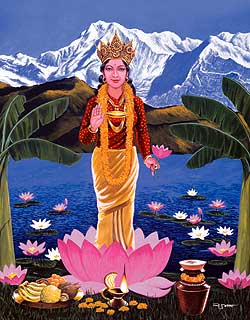 Ascant two weeks after Dasai winds down, Nepalis are gathering second wind for the next big festival: Tihar. This harvest festival is a celebration of life-animals are worshipped instead of slaughtered. Though many of the rituals remain intact, the origins of Tihar are murky. Theories abound that it is most likely rooted in animism associated with ancient harvest festivals.
Ascant two weeks after Dasai winds down, Nepalis are gathering second wind for the next big festival: Tihar. This harvest festival is a celebration of life-animals are worshipped instead of slaughtered. Though many of the rituals remain intact, the origins of Tihar are murky. Theories abound that it is most likely rooted in animism associated with ancient harvest festivals. As the story goes, there was once a king whose demise had been foretold. Following the advice of court astrologers, the king lit oil lamps through the night. Death, arriving in the form of a venomous snake, extinguished the flickering light. When the queen went out to appease the snake, he was so flattered, he decided to grant the king a longer life. Humbled, the king decreed a annual festival of lights. Today, the festivities are an elaborate five-day affair.
Yama Panchak, as Tihar is also called, began with Kag Tihar on Thursday when crows, who are considered pesky scavengers 364 days a year are worshipped as the vehicle of the God of Death. If unplacated, these messengers of Yama Raj are believed to be harbingers of bad news.
Friday, Kathmandu's dogs have their day. It is Kukur Tihar, the day dogs are gods. Even street mongrels sport elaborate marigold necklaces and vermilion on their heads. As Yama Raj's gatekeepers, they ensure the soul's journey to judgement.
Goddess Laxmi, guardian of wealth, is venerated on Saturday. Cows, worshipped as her earthly manifestation, are bathed, blessed and the sacred thread of protection is tied to the tail. "On our farms, a cow that gives milk and manure brings wealth, which is probably why they became symbols for Laxmi," explains Saraswati Jirel a self-proclaimed expert on Tihar. Women devote Laxmi Puja to cleaning house and replastering walls and floors with a mixture of rato mato and gobar. Tradition has it that the goddess deigns to visit only the cleanest homes and come evening, its time for oil lamps and leaving the doors open for the goddess and wealth to glide in.
Saturday is also the night of women's bhailo songs for blessings, money and sweets. The men have their deosi on Sunday. In the old days perfect strangers would call in at all the big, well-known families but in these troubled times, both bhailo and deosi are restricted to families and close friends. Word has it that groups have to formally register with the police and send out notices to the houses that they intend to visit.
Sunday is celebrated by various communities in their own way. Farmers worship their tools and their bull to keep the working animal healthy and safe. Most households perform gobardhan puja on a mound of cow dung which symbolises the mountains, and farmers pray for rain, fertile fields and an abundant harvest.
Sunday is also the Newari New Year, which began in 880AD, and the day of Mha Puja when we worship oursleves because each individual is believed to be an embodiment of the divine. Bhaktapur resident Janak Kakshyapati describes the scene in at home on Mha Puja. "My immediate family members sit in a room, each with their individual mandap in front of them for a ceremony which can last for hours. We offer auspicious foods like boiled eggs and fish, fruit and decorations, first to the mandap, then to ourselves." This ritual of self-purification is performed in the same room as other family members, becoming a ritual that celebrates individualism, while strengthening kinship within families.
On Monday is Bhai Tika, the day sisters and brothers bless each other with long life and happiness symbolised by long multicolour tikas and chrysanthemum garlands. It is also a time for siblings to offer each other presents.
In the past decade or so, Nepali Tihars have begun to take on shades of India's Dipawali. While purists frown on the old ways not remaining sacrosanct, the kernel will survive and continue because Nepalis are resilient and hopeful. This Tihar, all over the country, the lamps that are lit will also be for peace.


